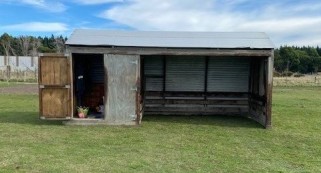Horse Facilities
Are my facilities suitable for horses? How will this be assessed?
Horses have access to shelter from sun, rain, wind, and adverse weather condition.

When ambient temperatures are extreme, horses are monitored more frequently than usual, animal behaviour is observed, and corrective action taken if needed. Clipped horses are protected from the cold by stabling or wearing rugs. Horses have no skin lesions due to rubbing of the rugs or covers.
Sharp objects, protrusions, edges, gaps and damaged flooring likely to cause injury to have been removed, repaired or covered.
All stable and barn doorways are wide enough for a horse and handler to move through easily. Floor surfaces are not slippery.
Grain based feeds, health remedies, toxic materials and associated equipment are securely stored and unable to be accessed by horses. No toxic paint or timber preservatives are used.
Personnel take action to rectify any problems, or potential problems, with facilities that are apparent upon inspection of horses within the facilities. Handlers are trained and familiar with the operation of facilities and understand how incorrect operation may affect the horses in their care.
For stabled horses they should have enough room to lie down and rest; turn around comfortably; and roll without becoming cast. They need sufficient bedding to prevent injury and allow a comfortable rest. Water containers must not cause injury. Appropriate fire prevention measures and an emergency plan should be devised and documented, and personnel trained to implement it. Damp straw or hay used as bedding should not be stored in or near stables as it is a common cause of fires. Smoking in stable areas should be prohibited due to the risk of fire. Contingency plans are in place for dealing with any hazards or emergencies and include the ability to rapidly release horses into a safe and secure environment.
Stalls must provide sufficient space for a horse to be led in and turned around, to reduce possible injury associated with moving horses backward into position. Horses may be tied in a stall, but for no more than 6 hours in a 24-hour period, unless under veterinary recommendation, and while untied must receive daily exercise.
Industry Information
- Getting Started
-
Health and Animal Care
- Horse Care Regulations
- Standardbred Care
- Tracing our Standardbreds
- Caring for our Standardbreds
- Health and management
- Life After Racing
- Life After Racing Grants
-
Life After Racing Superstars
- Bacardi Royal
- Admirals Flight
- Artfilly
- Artique
- Ashleighs Flight
- Aztec Shard
- Bad Desire
- Battle Commander
- Bettor's Strike
- Better Than Most
- Bonnie Doon
- Boom Gate
- Bordeaux
- Bourbon Street
- Bronze Jay
- Can't Believe Myeyes
- Charismatic
- Charlie Chuckles
- Charley's Pride
- Cheyenne
- China Cat
- Clockwork Special
- Comedy Act
- Cullens Spirit
- Danube
- Destined To Be
- Dontgetmerong
- Dream Major
- Dusky Eyre
- Easy Vance
- Enth Degree
- Extreme Robyn
- Flamin Shard
- Fort William
- Fortune Smiles
- Franco Cristiano
- Franco Santino
- Franco Tetrick
- Galleons Knight
- Golden Future
- Gouda
- Halla
- Harold Scott
- Helenearth
- Hurricane Banner
- Irish Moss
- Itchycoo Park
- Kiel
- Kilbeggan
- King Chevron
- King Tut
- Laila Franco
- La La Lives
- La Vie Dansante
- Lambourne Road
- Land A Dream
- Lars Christian
- Lasvegasherewecome
- Lavra Euta
- Lavros Spur
- Lets Elope
- Lincoln Hanover
- Lindens First
- Little Mo
- Love Watching
- McRough
- Mad Max
- Magic Morris
- Magnate Mara
- Major Ouch
- Malak Alby
- Maldito
- Maravu Still Lives
- Master Jonty
- Master Lavros
- Minnie Mouse
- Mister Seven Up
- Mister Slick
- Monkey King
- Mouton
- Myboylolliepop
- Nova
- Olivia Brew
- O'Sheas
- Painted Black
- Peeping Thru
- Pegasus Speed
- Pip
- Rare Exception
- Rebel Richie
- Regalmahon
- Rio Lenardo
- Run Fatboy Run
- Silver Surfer
- Simply Special
- Sparkling Life
- Speedy Lavros
- Spice And Spark
- Spirit of Algeria
- Spirit Of Ireland
- Starlights Sister
- Steen
- Stunning Shadow
- Sunny Pegasus
- Swift And Smart
- Sylvan Ruler
- Tad Lucas
- Tartan Trilogy
- Tenacious Bromac
- Testarossa
- Thanks Shane
- The C E O
- Thefixer
- The Graceful Lady
- The Guardsman
- The Outlaws Rule
- The Tin Soldier
- Trina Jaccka
- Turnbulls
- Western Bay
- Will Take Charge
- Wonder Anvil
- Worthy Pride
- Young Charlie
- Zippys Bro
- Zippidy Doodah
- HRNZ Microchipping
- Notifiable Surgeries and Procedures
- Key Welfare Numbers
- Ownership
- Education and Training
- HERO
- Amateur Driving
- Media & Links
- National Forum